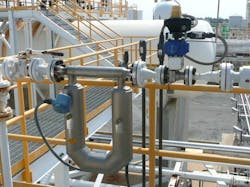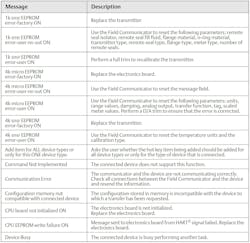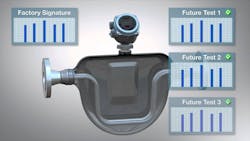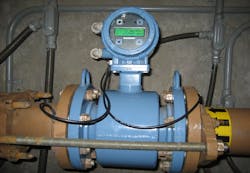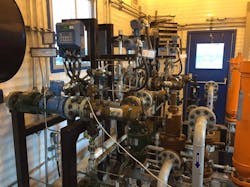Device diagnostics ensure instrument health
In the first article of this series, we took a high-altitude overview of the basics of instrumentation diagnostics, looking at six ways these capabilities are used in process manufacturing environments. In this, our second installment, we will do a deeper dive into the first area: device diagnostics. This information is what an instrument is telling us about itself, which is where the whole diagnostics concept began.
Instrument diagnostics grew out of the development of transmitter electronics necessary to linearize, range and convert raw analog data into engineering units, and to standardized data transmission formats (e.g., 4-20 mA current loops). As the data analytics capabilities of transmitter electronics grew in sophistication, adding diagnostic capabilities was the next development step.
Once communication protocols such as HART and Foundation Fieldbus became available, they provided the means for an instrument, such as a pressure transmitter, to convey new types of information in addition to the main process variable. Given the limited amount of bandwidth available, these messages had to be very short, necessitating use of codes and abbreviations (Figure 1).
These messages provide a lot of information, but interpreting them calls for a reference manual and a well-trained instrument technician. Scrolling through the full list will show that they all refer to the transmitter’s condition or configuration. Nonetheless, this level of communication became, and remains, the basis for many successful reliability programs.
As transmitter electronics and software have evolved, the amount of information that can be collected and the depth of analysis has increased. When this is combined with improving the human interface, more intuitive approaches are available, capable of conveying information in ways that are easier to understand. Along these lines, Emerson has developed its Smart Meter Verification platform to help operators and reliability teams improve performance and reduce maintenance for three widely used flow metering technologies: Coriolis, magnetic and ultrasonic.
Establishing benchmarks
Like a person’s medical record, it is important to determine what is normal, and then look for changes over time. When Emerson completes a flowmeter installation included in this program, it undergoes a series of tests to determine its initial characteristics, or we can say, its signature (Figure 2) that can be imprinted in the transmitter’s memory. The objective is to perform this test again, whenever desired, to verify that nothing has deviated from the original signature.
After a flowmeter is installed, a new normal is established when it enters service. For example, with a Coriolis flowmeter, Smart Meter Verification methodology includes a second test to establish a field reference point determined by operators as the new “normal” when the process is in stable operation. This new reference point is combined with the factory signature to create the benchmark for this flowmeter in this application. Both are included in the transmitter’s firmware and used each time the Smart Meter Verification test is executed. Naturally, tests should be executed when the process is running near its steady-state level.
What can it indicate?
Smart Meter Verification can determine more nuanced changes than original device diagnostic indicators. Those original diagnostics are still valid and necessary, but they cannot capture changes such as a subtle shift in the stiffness of a Coriolis flowmeter tube, or a nearly imperceptible drift in the transducer for an ultrasonic flowmeter. Such changes are very rare but can happen and must be detected immediately. The ability to perform a test while the process is still running to verify that the flowmeter is operating as well as the day it was installed gives operators confidence that the process is right where it needs to be.
While improving the mindset of operators is important, there are also more tangible effects, such as extending the interval between calibrations for the relevant flowmeter families. The introductory article took a brief look at one facility where this proved a major benefit. Let’s dig deeper and get more detail, plus look at two more case studies in other industries.
Wastewater treatment: diagnostics reduce operating costs
A large wastewater treatment plant in the western U.S. had frequent disruptions during the times activated sludge moved between sludge treatment and wastewater treatment stages in the facility. Measuring these transfers is critical as they determine the chemical dosing required to support the viability and action of biologically active organisms in the sludge. The plant had been operating with a series of old magnetic flowmeters that were troublesome and tended to move out of calibration, requiring operators to check measurements manually, and frequently leading to overdosing of the costly additives.
Recalibrating the old flowmeters required removing them from service, which was a time-consuming and decidedly unpleasant process, highly unpopular with technicians. Consequently, flowmeters were left in place longer than they should, resulting in inaccurate measurements and operational problems, including additional manual readings, followed by manual adjustments to plant operating records.
To solve these issues, the plant replaced the flowmeters with Emerson’s Rosemount 8750W Magnetic flowmeters for utility water applications (Figure 3), which work well for this service because they can handle the solids content common to wastewater treatment without clogging. The meters included Smart Meter Verification diagnostic capability, allowing facility personnel to verify meter calibration without removing each meter. Initially, the practice of meter verification every three months continued. However, after nine months, operators realized this was overkill and extended calibration to six, and even 12 months in some applications. The 8750W flowmeters have been stable since installation, as indicated by Smart Meter Verification test cycles.
The facility realized several positive outcomes as a result. With accurate flow readings, biological activity of the sludge was maintained at the desired level, increasing treatment efficiency and reducing the need for chemical additive use. The need for manual checks of material balance and manual adjustments to plant records declined, leading to lower operating costs. With more consistent biological activity in the sludge, the plant maintains maximum throughput.
Oil & gas: monitoring polymer injection for EOR
Approaches for enhanced oil recovery (EOR) from mature wells include secondary techniques, such as carbon dioxide injection and water injection. When these are no longer effective, there may still be significant volumes of oil, but producers must move to tertiary methods, such as polymer injection. This approach creates a more solid wall of injected material to push oil toward a production well, increasing recovery rates.
Canadian Natural Resources Limited (CNRL) uses this method across many of its mature wells in Alberta, Canada. In this application, the company maintains 775 magnetic flowmeters on skid systems to monitor water and polymer injection across its production fields (Figure 4). The Provincial Alberta Energy Regulator requires CNRL to physically pull and inspect every flowmeter at least once per year in its maintenance shops under its Directive 17 regulations. CNRL must take coil and electrode readings manually to verify the health of the meter, and to inspect the liner and electrode condition to ensure measurement integrity.
Physically removing and inspecting meters every year is a time-consuming and costly process that requires process shutdowns with lost production. Moreover, removing and reinstalling meters can result in damage that degrades performance.
When CNRL presented Emerson’s Smart Meter Verification methodology to the agency as an alternative to manual inspection, the agency concluded that the diagnostics provided the same or better information as gained through manual inspection, better because no error-prone manual data recording was necessary. The biggest improvement, as the agency realized, was the ability to have these diagnostic tests performed far more frequently, and even continuously, rather than just annually.
In addition, Smart Meter Verification can predict when a magnetic flowmeter is nearing the end of its life, allowing CNRL to plan its replacement during scheduled downtime, eliminating a production interruption. CNRL installed Smart Meter Verification on existing meters in the field, saving $687 dollars per meter per year, multiplied by 775 meters, for a total savings of $532,425 per year.
Chemical producer: greenhouse gas measurement
A U.S.-based hydrofluorocarbon (HFC) refrigerant producer faced a major capital investment hurdle plus recurring operating costs to bring itself into compliance with new and tighter environmental regulations on a short deadline. The company was seriously concerned as the requirements initially advanced called for very high accuracy requirements of ±0.2% for daily mass balance, which is difficult to attain with most measurement devices. This was supplemented by mandatory annual wet calibrations for all flowmeters, which would be expensive and cause process disruptions.
The company anticipated compliance would require replacing most of its flowmeters and adding gas chromatographs at strategic points around the production unit. The initial capital cost was estimated at $300,000 with additional recurring costs of $300,000 per year.
Emerson, along with multiple manufacturers, negotiated with the agency as the regulation was being finalized. Once more practical measurement technologies were understood, the mass balance accuracy requirements were relaxed to ±1%, and the manufacturer's recommended schedule for flowmeter calibration was accepted, rather than arbitrary annual calibrations.
In light of the new specs, Emerson provided the company with an integrated equipment and software solution covering measurement through documentation stages, in compliance with the final standard. It employed Micro Motion Coriolis flowmeters with Smart Meter Verification, Emerson’s Smart Wireless THUM and a WirelessHART Gateway.
Smart Meter Verification technology allowed the company to perform an in-situ check, eliminating the need for expensive and inconvenient wet calibrations. Smart Wireless THUM and Gateway technology provided easy access to the flowmeters from the instrumentation shop via a WirelessHART network, allowing the company to generate all calibration documents required for reporting. Emerson's AMS Suite software enabled the Smart Meter Verification audit trail, which assured complete documentation.
This approach cut measurement costs by half, and it improved safety because piping could remain intact during calibration. Additionally, process interruptions were reduced, the need for redundant metering was eliminated, equipment health improved and required maintenance activities were greatly reduced.
Diagnostics delivers tangible benefits
The common element of these case studies is the value of giving an instrument the ability to speak for itself, diagnosing its own condition on multiple levels, rather than forcing instrument technicians to dig out an answer the hard way. Companies that were early adopters of condition-based maintenance found they could detect when problems were forming, allowing them to act proactively before an unscheduled outage happened. More sophisticated diagnostics, such as Smart Meter Verification, extend this concept to minimize the need for calibrations.
In the next three articles in the series, we will look at what instrument diagnostics can determine about a process, how they can point out installation and maintenance problems, and how to implement practical end user solutions. Instruments provide a wealth of data, and advancements continue to turn this data into actionable and useful information.
Kelly Albano has been with Emerson for over 12 years and is a product manager for Emerson Coriolis transmitters and software. She is focused on improving user experiences and guiding users through digital transformations. Albano holds an undergraduate degree in Environmental Engineering from University of Colorado at Boulder, and an MBA with a Marketing Management Certificate from Colorado State University.
About the Author

Kelly Albano
Product manager for Emerson Coriolis transmitters and software at Emerson
Kelly Albano has been with Emerson for over 12 years and is a product manager for Emerson Coriolis transmitters and software. She is focused on improving user experiences and guiding users through digital transformations. Albano holds an undergraduate degree in Environmental Engineering from University of Colorado at Boulder, and an MBA with a Marketing Management Certificate from Colorado State University.
